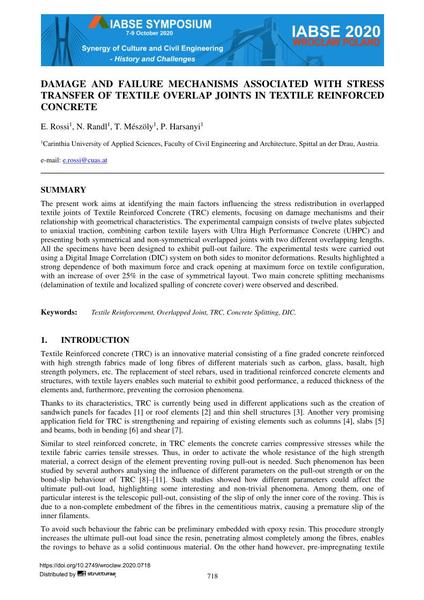Damage and Failure Mechanisms Associated with Stress Transfer of Textile Overlap Joints in Textile Reinforced Concrete

|
|
|||||||||||
Bibliographic Details
| Author(s): |
E. Rossi
N. Randl T. Mészöly P. Harsányi |
||||
|---|---|---|---|---|---|
| Medium: | conference paper | ||||
| Language(s): | English | ||||
| Conference: | IABSE Symposium: Synergy of Culture and Civil Engineering – History and Challenges, Wrocław, Poland, 7-9 October 2020 | ||||
| Published in: | IABSE Symposium Wroclaw 2020 | ||||
|
|||||
| Page(s): | 718-725 | ||||
| Total no. of pages: | 8 | ||||
| Year: | 2020 | ||||
| DOI: | 10.2749/wroclaw.2020.0718 | ||||
| Abstract: |
The present work aims at identifying the main factors influencing the stress redistribution in overlapped textile joints of Textile Reinforced Concrete (TRC) elements, focusing on damage mechanisms and their relationship with geometrical characteristics. The experimental campaign consists of twelve plates subjected to uniaxial traction, combining carbon textile layers with Ultra High Performance Concrete (UHPC) and presenting both symmetrical and non-symmetrical overlapped joints with two different overlapping lengths. All the specimens have been designed to exhibit pull-out failure. The experimental tests were carried out using a Digital Image Correlation (DIC) system on both sides to monitor deformations. Results highlighted a strong dependence of both maximum force and crack opening at maximum force on textile configuration, with an increase of over 25% in the case of symmetrical layout. Two main concrete splitting mechanisms (delamination of textile and localized spalling of concrete cover) were observed and described. |
||||
| Keywords: |
textile reinforcement DIC TRC Overlapped Joint Concrete Splitting
|
||||
